Church of Denmark
The Evangelical-Lutheran Church in Denmark or National Church, sometimes called Church of Denmark (Danish: Folkekirken, literally: "The Folk's Church" or unofficially Danish: Den danske folkekirke, literally: "The Danish Folk's Church"), is the established, state-supported church in Denmark.[3] The reigning monarch is the supreme secular authority in the church.[4] As of 1 January 2019, 74.7% of the population of Denmark are members,[2] though membership is voluntary.[5]
| Evangelical-Lutheran Church in Denmark | |
|---|---|
| Folkekirken | |
 | |
| Classification | Protestant |
| Orientation | Lutheran |
| Scripture | Protestant Bible |
| Theology | Lutheranism |
| Polity | Episcopal |
| Head | Margrethe II of Denmark |
| Minister for Ecclesiastical Affairs | Joy Mogensen |
| Primate | Peter Skov-Jakobsen |
| Diocese | 11 |
| Parishes | 2,163 (November 2019)[1] |
| Associations | |
| Region | Kingdom of Denmark (including Greenland, excluding Faroe Islands) |
| Language | Danish |
| Origin | 1536 |
| Separated from | Roman Catholic Church |
| Separations | |
| Members | 4,339,3511 (74.7%, January 2019)[2] |
| Church buildings | 2,354 (2014)[1] |
| Aid organization | Folkekirkens Nødhjælp |
| Official website | Official website (in Danish) Official website (in English) |
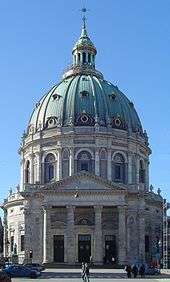

Catholic Christianity was introduced to Denmark in the 9th century by Ansgar, Archbishop of Hamburg-Bremen. In the 10th century, King Harald Bluetooth became a Catholic and began organizing the church, and by the 11th century, Christianity was largely accepted throughout the country. Since the Reformation in Denmark, the Church has been Evangelical Lutheran, while retaining much of its pre-Reformation liturgical traditions. The 1849 Constitution of Denmark designated the church "the Danish people's church" and mandates that the state support it as such.[6]
The Church of Denmark continues to maintain the historical episcopate. Theological authority is vested in bishops: ten bishops in mainland Denmark and one in Greenland, each overseeing a diocese. There is no archbishop; the Bishop of Copenhagen acts as a primus inter pares.
Organization
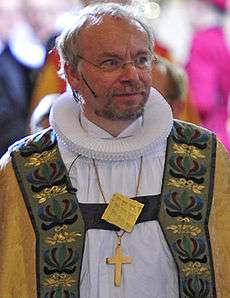
Dioceses
The Church of Denmark is organized in eleven dioceses, each led by a bishop, including one for Greenland (the Faroe Islands was a twelfth diocese until 29 July 2007). There are no archbishops; the most senior bishop (primus inter pares) is the Bishop of Copenhagen, currently Peter Skov-Jakobsen. The further subdivision includes 111 deaneries and 2,200 parishes. There are about 2,400 ordained pastors (Danish: præst).[7]
| Diocese | Founded | Cathedral | Incumbent |
|---|---|---|---|
| Diocese of Aalborg | 1554 | Aalborg Cathedral | Bishop Henning Toft Bro (2010– ) |
| Diocese of Aarhus | 948 | Aarhus Cathedral | Bishop Henrik Wigh-Poulsen (2015– ) |
| Diocese of Copenhagen | 1537 | Copenhagen Cathedral | Bishop Peter Skov-Jakobsen (2009– ) (Primate of Denmark) |
| Diocese of Funen | 988 | St. Canute's Cathedral | Bishop Tine Lindhardt (2012– ) |
| Diocese of Haderslev | 1922 | Haderslev Cathedral | Bishop Marianne Christiansen (2013– ) |
| Diocese of Helsingør | 1961 | Helsingør Cathedral | Bishop Lise-Lotte Rebel (1995– ) |
| Diocese of Lolland–Falster | 1803 | Maribo Cathedral | Bishop Marianne Gaarden (2017– ) |
| Diocese of Ribe | 948 | Ribe Cathedral | Bishop Elof Westergaard (2014– ) |
| Diocese of Roskilde | 1922 | Roskilde Cathedral | Bishop Peter Fischer-Møller (2008– ) |
| Diocese of Viborg | 1537 | Viborg Cathedral | Bishop Henrik Stubkjær (2014– ) |
| Diocese of Greenland | 1993 | Nuuk Cathedral | Bishop Sofie Petersen (1995– ) |
Parishes
Each parish has a parochial council, elected by church members in four-year terms. The parochial council leads the practical business of the local church and decides employment of personnel, including the pastors, musicians, verger, and sacristan. The pastor (Danish: præst) is subordinate to the council, except in spiritual matters such as conducting church services and pastoral care. Parishes in the same local area are grouped into Deaneries, with one priest serving as Rural Dean. Deaneries, parochial councils, and pastors are all subordinate to the bishop of the diocese.
Voluntary congregations
A special feature is the possibility of creating voluntary congregations (valgmenighed) within the Church. These account for a few percent of church members. They are voluntary associations, electing their own parochial council and parish pastor, whom they agree to pay from their own pockets. In return, they are exempt from church tax. The voluntary congregation and its pastor are subordinate to the bishop of the diocese, and members remain full members of the Church. Historically, when a parish was dominated by a conservative majority and priest, the liberal minority would often set up a voluntary congregation with their own priest - and vice versa. Today the voluntary congregations are often a solution for people who find the idea of a free church appealing, but wish to keep some bonds to the church.
Parish optionality
Another, less commonly used feature is parish optionality (sognebåndsløsning, literally "parish bond release"). If a Church member is dissatisfied with the particular pastor of his residence parish, he may choose to be served by another pastor who matches better with his Christian views, for example in a neighbouring parish.
Membership
| year | population | members | percentage | change annually |
|---|---|---|---|---|
| 1984 | 5,113,500 | 4,684,060 | 91.6% | |
| 1990 | 5,135,409 | 4,584,450 | 89.3% | 0.4 |
| 2000 | 5,330,500 | 4,536,422 | 85.1% | 0.4 |
| 2005 | 5,413,600 | 4,498,703 | 83.3% | 0.4 |
| 2007 | 5,447,100 | 4,499,343 | 82.6% | 0.4 |
| 2008 | 5,475,791 | 4,494,589 | 82.1% | 0.5 |
| 2009 | 5,511,451 | 4,492,121 | 81.5% | 0.6 |
| 2010 | 5,534,738 | 4,479,214 | 80.9% | 0.6 |
| 2011 | 5,560,628 | 4,469,109 | 80.4% | 0.5 |
| 2012 | 5,580,516 | 4,454,466 | 79.8% | 0.6 |
| 2013 | 5,602,628 | 4,430,643 | 79.1% | 0.7 |
| 2014 | 5,627,235 | 4,413,825 | 78.4% | 0.7 |
| 2015 | 5,659,715 | 4,400,754 | 77.8% | 0.6 |
| 2016 | 5,707,251 | 4,387,571 | 76.9% | 0.9 |
| 2017 | 5,748,769 | 4,361,518 | 75.9% | 1.0 |
| 2018 | 5,781,190 | 4,352,507 | 75.3% | 0.6 |
| 2019 | 5,806,081 | 4,339,511 | 74.7% | 0.6 |
| Statistical data: 1984,[8] 1990-2019,[2] Source: Kirkeministeriet | ||||
According to official statistics from January 2019, 74.7% of Danes are members of the Church of Denmark, one percent less than the previous year.[2] Membership rates vary from 56.9% in the Diocese of Copenhagen to 84.2% in the Diocese of Viborg. In recent decades, the percentage of Danes that are members of the church has been slowly declining, the most important reasons being immigration from non-Lutheran countries, withdrawal of some members, and a somewhat lower rate (59.5%) of Danish infants being christened.[9]
Any person who is baptised (usually infant baptism) into the Church of Denmark automatically becomes a member. Members may renounce their membership and later return if they wish. Excommunication is legally possible but an extraordinarily rare occurrence. Examples include declared Satanists. A church member supporting reincarnation was excommunicated, but the Supreme Court overturned the excommunication in 2005.
Faith and church attendance
According to the latest inquiry about 2.4% [10] of church members attend services every week, although on Christmas Eve more than a third of the population attend. However, the church is still widely used for traditional family ceremonies including christenings and confirmations. In the year 2017, 32.7% of weddings[11][12] and 83.3% funerals were performed in the Church of Denmark,[13] and 70% of children in grade 7–8 were confirmed.[14] The level of weekly church attendance is similar to that in Norway and Sweden.
According to a 2009 poll, 25% of Danes believe Jesus is the Son of God, and 18% believe he is the saviour of the world.[15]
Doctrine
The church is aimed at having a wide acceptance of theological views, as long as they agree with the official symbolic books as stipulated in the Danish Code of 1683. These are:
- The Apostles' Creed
- The Nicene Creed
- The Athanasian Creed
- The Augsburg Confession
- Luther's Small Catechism
Revised versions of the Old and New Testament were authorised by the Queen in 1992. A revised Hymn Book was authorised in 2003. Both the Bible translations and the Hymn Book implied widespread public and theological debate.
Historically, there is a contrast between a liberal current inspired by N. F. S. Grundtvig and more strict, pietist or Bible fundamentalist movements (such as Indre Mission). These tensions have sometimes threatened to divide the Church. Tidehverv is a minor fraction based on a strict Lutheranism and anti-modern, national-conservative views.[16][17]
The Church of Denmark is member of the Porvoo Communion between Lutheran and Anglican Churches.
Liturgy
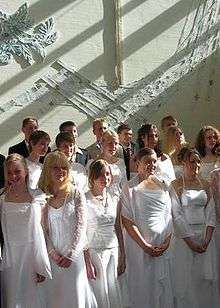
The Communion Service includes three readings from the Bible: a chapter from one of the Gospels, from one of the Epistles or another part of the New Testament and, since 1992, from the Old Testament. Texts are picked from an official list following the church year. Some liturgical features have a fixed content but are free to the form. This accounts for the Common Prayer following the sermon, where the priest is encouraged to mention the royal house. Some will simply mention "the Queen and all her House" whereas others will list all members of the royal house by name and title.
The sermon, as in other Protestant churches, is a central part of the service. The priest takes a starting point in the text of that Sunday, but is free to form a personal message of it. At special occasions, even non-priests may be allowed to preach. Hymns are also very central. In contrast to Roman Catholic and Anglican churches, Danish congregations sit while singing and stand while listening to Bible readings.
As in other Lutheran churches, the Church of Denmark recognizes only two sacraments, Baptism and the Lord's Supper. These are usually included in the Communion Service. Formerly, individual or shared confession was a condition to receive the Lord's Supper. An official confession ritual still exists, but is now used very rarely. There are also official rituals for confirmation, wedding, blessing of a civil wedding and funerals. Emergency baptism may be performed by any Christian if necessary, and later the child will then be "produced" in Church.
Church and state
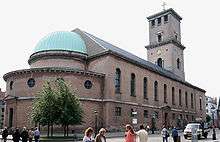
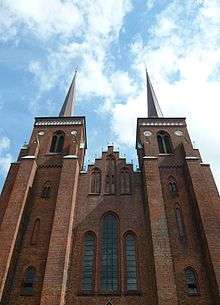
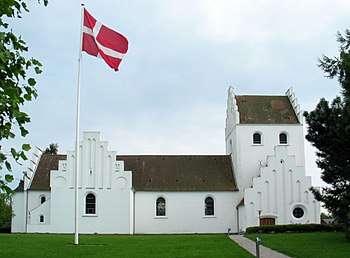
As supreme authority of the Church of Denmark, the monarch must be a member (article 6 of the Constitution). This applies to the royal princes and princesses as well, but does not apply to their spouses. Traditionally, though, every foreigner who has become a member of the royal family has converted or become a member of the church; as a result, the Prince Consort Henrik converted from Catholicism before marrying the Queen in 1968, and Mary Donaldson also converted from Presbyterianism before marrying Crown Prince Frederik in 2004.
Freedom of religion
With the Reformation in Denmark in 1536, Lutheran Christianity was established as the state religion. For the next century, in a time when religious wars swept Europe, harsh persecution of other faiths followed (Lutheran orthodoxy). Exceptions were granted only to foreign diplomats. For at least a period in the 16th century, small circles of clandestine Catholicism prevailed. From 1683, Roman Catholic, Reformed and Jewish congregations were allowed in the new town of Fredericia, the latter two also in Copenhagen. Non-Lutherans were also allowed in Friedrichstadt and on Nordstrand in Slesvig and in Glückstadt in Holstein. With the constitution of 1849, freedom of religion was introduced in Denmark, but Lutheranism remained the state church.
Recognised and approved religions
A religious community does not need any state approval in order to enjoy the freedom of religion granted by the constitution. However, state-approved congregations (godkendte trossamfund) enjoy several privileges. They may conduct legal weddings, establish own cemeteries, get residence permits for foreign priests, are exempt from corporate and property tax, may apply for means from the state lottery fund, and members may tax-deduct membership fees and presents to the congregation.
Additionally, those congregations recognised by royal decree before 1970 (anerkendte trossamfund) may name and baptize children with legal effect, keep their own church registers and transcribe certificates on the basis of such registers.[5]
This legal distinction between "recognised" and "approved" communities remains, but is mainly a historical one. Communities recognised before 1970 includes only eight well-established Christian communities as well as one Jewish community. From 1970 until the 1990s only a few more Christian congregations were approved, but since 1998, a much more liberal practice has ensued. Since then, a board of independent experts decide about approval of new religious communities. The board includes professors of law, religious studies and theology and works under the Ministry of Justice, deliberately separate from the Ministry of Ecclesiastical affairs. It merely investigates whether the organisation fulfills basic definitions, such as having a doctrine, creed and cult, in order to be called a congregation of faith. In 2003, the approval of the Forn Sed religion caused some public debate.
Lack of central authority
The Church is in practice barred from having official positions in political or other matters, since it has no central bodies that could define such stances: nor a spiritual leader (such as an archbishop), nor a central assembly or synod. Bishops have the last say on doctrinal questions within their respective dioceses. The Queen (in practice the Minister of Ecclesiastical Affairs) and Parliament are the central bodies, but they usually keep to administrative matters and abstain from interfering with spiritual questions. Church laws are rarely changed, and, when it happens, only administrative matters are affected.
Firstly, these principles are generally believed to ensure a non-sectarian, tolerant church where parishioners and priests enjoy a high degree of freedom to practise their own interpretation of Lutheran Christianity. Secondly, many Danish politicians and theologians claim that only this church-state-model will ensure the division of politics and religion, since the Church cannot interfere with political matters or even claim to speak with one voice on behalf of its members. They frequently discourage the term state church and argue it is, as its name states, the "people's church".
Article 66 of the Danish Constitution stipulates a church ordinance shall be laid down by law. This promissory clause dates back from the first Constitution of 1849 but was never put into practice. It was feared that splits could occur if a central authority were created.
In very few cases have politicians deviated from their traditional hands-off course in church doctrinal matters. Where they have done so, it has been with the declared aim of preventing a possible split in the church. See the issues of Female clergy and Same-sex marriage above.
Civil registration
The Church of Denmark conducts civil registration of births, deaths, change of name etc. (vital records). The keeping of such kirkebøger ("church books") is a centuries-long tradition, dating from when the parish rectors were the only government representatives in rural areas. In 2002-03 the traditional church records were replaced by a new national electronic registration system called Personregistrering. After protests in 2005, the Minister for Education and Ecclesiastical Affairs Bertel Haarder announced that people who for various reasons did not want to send their registration forms (e.g. births and namings) to the local church office could now send their forms to a central office located in Nykøbing Falster.
In 2010 parents' duty to report the birth of their child was abolished. Instead, it was decided that in the future it was the task of the midwives to report all births in Denmark (only when a midwife isn't present at the birth of a child are the parents still obliged to report the birth of the child).
From 1 December 2014 all applications should be submitted in digital form whenever possible.
Economic support
Article 4 in the Constitution of Denmark stipulates that "The Evangelical Lutheran Church shall be the Established Church of Denmark, as such, it shall be supported by the State."[18] On the other hand, article 68 ensures that citizens are not obliged to pay personal contributions to any religion other than their own.[18] It has been questioned how these two principles can co-exist. Non-members do not pay church tax, but an additional state subsidiary accounts for 12% of the Church's income. This means every citizen, even a non-member, contributes with an average of 130 kroner annually (US$23). In addition, the bishops are high-ranking officials whose salary is fully paid by the state. In return, certain public tasks are carried out by the Church, such as conducting vital records registries and managing graveyards which are open to all denominations.
Separation of church and state
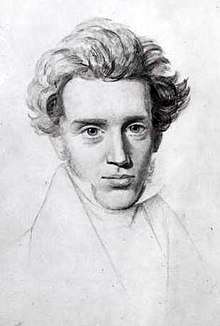
While the debate about separation of church and state emerges occasionally in Denmark, the current arrangement is supported by most political parties. It has been challenged for decades by the left wing and by atheists; more recently also by some ideological liberals and some members of free churches.
Proponents for a separation (disestablishment) argue the state church violates equality of religions and the principle of the secular state. Proponents for the current system argue that membership is voluntary, that the existence of a state church has ancient historical roots, and that the church fulfils certain administrative tasks for the state. They also argue it would be difficult to decide whether church-owned real estate should be handed over to the state or not. The former possessions of the Catholic Church were ceded to the Crown at the reformation in 1536.
According to a poll conducted by the free daily MetroXpress in April 2007, 52% wished to split church and state, 30% were against, and 18% undecided. Minister for Education and Ecclesiastical Affairs Bertel Haarder, spoke out against a split: "Church and state will be separated when more than half of the population are no longer members. N. F. S. Grundtvig said so, and I support that." The opposition Social Democrats also argued against a split, but said there should be more equality between denominations, possibly by a state subsidiary paid to other approved religious communities as well.[20] Immigrant groups and the Muslim society are divided on the issue, as some think official Christianity is preferable to a purely secular state.
Pure equality of religions exists only in a minority of Western European countries. Besides Denmark, only the Faroe Islands, Iceland, England and Greece have official state churches, while Scotland has an officially recognised "national church" that is not connected to the state. Spain, Portugal, Italy and Austria have official ties to Catholicism (concordat), but these ties do not extend to Catholicism being recognised as the state religion in these countries. Further there are varying degrees of public funding of the church in Belgium, Luxembourg, Germany, Norway, Sweden in most cantons of Switzerland, and in the Alsace-Moselle region of France.
Similar Nordic Evangelical-Lutheran churches
- Church of Sweden - Svenska kyrkan
- Church of Norway - Den norske kirke
- National Church of Iceland - Þjóðkirkjan
- Evangelical Lutheran Church of Finland - Suomen evankelis-luterilainen kirkko (Swedish: Evangelisk-lutherska kyrkan i Finland)
- Church of the Faroe Islands - Fólkakirkjan
Controversial issues
Female clergy
The ordination of women, having been discussed within the church since the 1920s, has been allowed since 1948, despite some rather strong early resistance from the clergy. The then Minister of Ecclesiastical Affairs was contacted by a parochial council who wished to employ a female priest. He decided there was no legal obstacle to that.[21] The first woman to become a bishop was instituted in 1995. Today two thirds of theology students are women, and the clergy is expected to have a female majority in the near future.
Among a small conservative minority, resistance to women ordained as clergy remains. In 2007 the Bishop of Viborg, known as a moderate conservative, revealed that he had given special consideration to priests who were known to be against ordained women. He had organised ordination ceremonies in such a way that new priests who so wished could avoid shaking hands with, or receiving the laying on of hands from, women ordained as priests. According to the bishop, this had happened twice in the 100 ordinations he had performed. The matter became headline news amidst a debate about Muslim fundamentalists who refuse to shake hands with members of the opposite sex. The Minister for Education and Ecclesiastical Affairs, Bertel Haarder, said he would discuss the matter with the bishops, but also stated that tolerance for various views should be respected. In contrast, the Minister for Employment, Claus Hjort Frederiksen, thought that the priests in question should be dismissed, as public employees are obliged to shake hands with anyone.[22]
Same-sex marriage
A 2011 poll of the Danish public found that 75.8% of Danes approve of same-sex marriages being performed in the church.[23]
According to a 2011 survey of 1137 priests, 62% of them supported same-sex marriage in the Church on the same basis as for heterosexuals, while 28% were against. A map of the results hints at the traditional west-east division, with a conservative wing being dominant in central West Jutland (the former Ringkjøbing Amt) and on Bornholm, but liberal priests dominating in most other cities.[24]
In 2004, a poll among pastors said 60% were against church marriage of same-sex couples.[25]
Early position of the church
Since Denmark approved same-sex civil unions (registered partnership) in 1989, the question of church blessing ceremonies for such unions emerged. After an enquiry from the Danish National Association of Gays and Lesbians in 1993, bishops set up a commission to reach a stance on the matter.
An early stance on registered partnerships was reached in 1997. Bishops maintained that the ceremony of marriage was God's framework for the relation between a man and a woman, but this view of marriage was not affected by the fact that some people chose to live in a responsible community with a person of the same sex, approved by society, i.e. a registered partnership. The bishops disapproved of institutionalising new rituals, but couples who wished a non-ritualised marking in church of their registered partnership should be obliged. In such cases, it would be up to the rector to decide, and he should seek advice from his bishop.[26]
At this time, many churches chose to bless registered partnerships, however this blessing was distinguished from a legal ceremony, which was performed by a mayor or another municipal official.[27]
Same-sex marriages accepted
On 15 June 2012 the Church of Denmark made the decision to perform same-sex marriage ceremonies and not merely bless them; therefore Denmark now recognises same-sex marriages. In early 2012 Minister for Equality, Ecclesiastical Affairs and Nordic Cooperation Manu Sareen introduced a bill approving same-sex marriage, which was passed in parliament in June 2012.[28] A wedding ritual with liturgy has been developed and presented to parliament by the eleven bishops who are in favor of same-sex marriages being performed in church.[29] Manu Sareen and a majority of bishops initially proposed the ritual would not declare the same-sex couple 'spouses', but 'life partners' (livsfæller, a Danish neologism), but the minister later changed his mind on this detail. Two conservative organisations within the church, Inner Mission and Lutheran Mission, as well as one of the twelve bishops, maintain their protests against same-sex marriage.[30] It will be up to each individual priest to decide whether he or she will conduct marriages of same-sex couples. The first same-sex couple was married on Friday 15 June.[31]
The process towards the official recognition of same sex marriage in the Church of Denmark began on 8 February 1973, when 'Provo Priest' Harald Søbye performed a wedding of a male couple, although not legally recognised, on a suggestion from a journalist at the newspaper Ekstra Bladet, which announced it as 'The World's First Gay Wedding'. On 25 February 1973 Harald Søbye performed another wedding, of a female couple, in a television programme. The state prosecutor investigated the cases, but concluded that the priest's use of his vestment was not illegal. Søbye had been retired in 1964 for political activism, but remained an ordained priest within the church. During the next 15 years, Søbye performed around 210 blessings or weddings of same-sex couples.[32]
When Denmark introduced registered partnerships in 1989, the issue of same-sex marriage for some years received little attention. Church blessings of these partnerships slowly gained ground (see above). Later, the possibility of registered partnership, or same-sex marriage, performed by the church came under discussion. The issue was brought up in an unusual way by Prime Minister Anders Fogh Rasmussen in 2004, who said he would approve of such a change, although he claimed to speak as a private person on this issue, not as prime minister.
Views among proponents vary whether such a ceremony should be called 'marriage' or merely 'registered partnership' (registreret partnerskab), as the present same-sex civil union is called. Most likely, clergy would be allowed to decide for themselves whether to perform same-sex marriages or not, similar to the right to deny remarriage of divorced persons (a policy employed by a conservative minority of priests).
Constitutionality
A further controversy is that this new practice may be against the Danish constitution; §4 of the Danish constitution states: "The Evangelical Lutheran Church shall be the Established Church of Denmark, as such, it shall be supported by the State."[18]
§4 not only establish "Folkekirken" as the state church, but also gives certain boundaries as to what the state church is. It is forced to follow the Lutheran doctrines and if, as some critics claim,[33] the Lutheran doctrines explicitly state that homosexuality is a sin then it is a violation of the constitution to allow gay marriages in the state church.
Gay clergy
Gay and lesbian clergy exist, and this is generally considered a strictly personal issue. Parish councils are central in selecting and employing new priests, including interviews with candidates. Once employed, parish priests are public servants and cannot be discharged except for neglect of duties, which will finally be the bishop's decision.
In 2011 a female priest serving two small island parishes was fired after controversies with the parish council of Agersø, while the neighbouring Omø supported her. She claimed to have been ousted because of her sexuality, but the parish council rejected this accusation and mentioned 'cooperation problems' as the cause. Twenty years ago she had come out as lesbian and a practitioner of sadomasochism in a Swedish TV programme.[34][35]
In 2009 a parish priest in Tingbjerg, a Copenhagen suburb, moved away from the parish to a secret address after assaults against his vicarage, his car and the parish church. The vicarage was put up for sale. According to Avisen.dk, local youths claimed they harassed him because he was openly homosexual, among other reasons.[36] The priest himself denied this was the issue, but rather claimed the assaults were part of a general tendency in the 'crumbling district', and intensified after he spoke out in public about the local youth crime.[37] A Sunday service held a few weeks later was attended by several prominent guests supporting the priest, including Prime Minister Lars Løkke Rasmussen, Minister for Education and Ecclesiastical Affairs Bertel Haarder, and photographer Jacob Holdt.[38] Tingbjerg is a single-plan public housing area, marked by gang violence and youth crime, and the most criminal district of Copenhagen.[39]
Declaration Dominus Iesus
In 2000, the Church of Denmark's ecumenical department publicly criticized the Roman Catholic declaration Dominus Iesus, which controversially used the term "ecclesial community" to refer to Protestant denominations, including Lutheran churches. The Church of Denmark argued that there is a destructive effect on ecumenical relations if one church deprives another of the right to be called a Church and that it is just as destructive as if one Christian denies another Christian the right to be called a Christian.[40]
See also
- Danish Seamen's Church and Church Abroad
- Danish Church in Southern Schleswig
- History of Denmark; for the history of the Church of Denmark
- Religion in Denmark
- Religion in the Faroe Islands
- Religion in Greenland
- Other Nordic national Lutheran churches
Notes and references
- Kinkel, Jens (16 November 2019). "Churches in Denmark". Danmarks Kirker (in Danish). Retrieved 16 November 2019.
- Church membership 1990-2019 Archived 2016-04-13 at the Wayback Machine Kirkeministeriet (in Danish)
- State fundings to the National Church Archived 2006-11-01 at the Wayback Machine (in Danish). Retrieved 21 January 2011
- kristendom.dk - "Dronningen og forholdet til folkekirken" - In Danish.
- Freedom of religion and religious communities in Denmark Archived 2012-02-05 at the Wayback Machine, Ministry of Ecclesiastical Affairs. Retrieved 21 January 2011.
- According to the Constitution of Denmark § 4, "the Evangelical-Lutheran Church is the Danish people's church and is supported as such by the State" ("den evangelisk-lutherske kirke er den danske folkekirke og understøttes som sådan af staten")
- Role description and numbers (currently 2,400) for a præst are shown on the official website of the church.
- Church membership 1984 Danmarks statistik (in Danish)
- Baptism statistics 1990 - 2017 Kirkeministeriet (in Danish)
- "Kun 2,4 procent går i kirke hver uge". Kristeligt Dagblad. Retrieved 20 June 2015.
- Kirkelig vielse og kirkelig velsignelser af borgerligt viede Kirkeministeriet (in Danish)
- Statistics Denmark Statistikbanken.dk
- Kirkelige begravelser Kirkeministeriet (in Danish)
- Confirmation statistics, Kirkeministeriet (in Danish)
- Poll performed in December 2009 among 1114 Danes between ages 18 and 74, Hver fjerde dansker tror på Jesus Archived 2009-12-25 at the Wayback Machine (One in four Danes believe in Jesus), Kristeligt Dagblad, 23 December 2009 (in Danish)
- "Tidehvervs forside - Bladet udkom første gang okt. 1926". Retrieved 20 June 2015.
- "Tidehvervsbevægelsen - Gyldendal - Den Store Danske". Retrieved 20 June 2015.
- "Denmark's Constitution of 1953" (PDF). Constitute Project. Retrieved 25 April 2016.
- Assiter, Alison, ed. (2012). Kierkegaard and the Political. Newcastle upon Tyne: Cambridge Scholars Pub. p. 81. ISBN 9781443843850.
- Danes want to split church from state Archived 2007-09-27 at the Wayback Machine, MetroXpress, 2007-04-04 (in Danish)
- Priests against marriage of homosexuals in church, Kristeligt Dagblad, 14 January 2004
- Minister for Employment: Fire the Discriminating Priests, Politiken, 2007-05-24 (in Danish)
- "The Post - The Copenhagen Post – Danish news in english". Retrieved 20 June 2015.
- Måling: Hver fjerde præst er imod homovielser (Poll: one of four priests against gay marriages), Danmarks Radio, 23 November 2011 (in Danish, with map)
- "Præster imod vielser af homoseksuelle i kirken" [Pastors against marriage of homosexuals in church]. Kristeligt Dagblad. 14 January 2004.
- Declaration of Bishops on same-sex unions, 1997 Archived 2007-09-11 at the Wayback Machine (in Danish)
- Bishop enters case about blessings of homosexuals, Kristeligt Dagblad, 4 August 2003 (in Danish)
- Denmark moves to legalize same-sex marriage, Digital Journal, 24 October 2011
- "You may now kiss the groom". Archived from the original on 16 June 2013. Retrieved 20 June 2015.
- "43 vrede præster udfordrer biskopperne". Retrieved 20 June 2015.
- "Endelig fik Steen og Stig kirkens ord". Retrieved 20 June 2015.
- da:Harald Søbye
- http://www.kristeligt-dagblad.dk/artikel/417323:Debat--DEBAT--Grundloven-goer-det-umuligt
- "dailymotion". Dailymotion. Retrieved 20 June 2015.
- Fyret præst: Min seksualitet gav problemer (Fired priest: My sexuality gave problems), Kristeligt Dagblad, 15 December 2011 (in Danish, with map)
- Tingbjerg-præst mobbes for at være homo (Tingbjerg priest harassed for being gay), Avisen.dk, 15 October 2009 (in Danish)
- Tingbjerg-præst: Man er overladt til sig selv (Tingbjerg priest: You are left to yourself), Kristeligt Dagblad, 17 October 2009 (in Danish)
- Politiker-støtte til chikaneret præst i Tingbjerg (Politicians support harassed priest in Tingbjerg), Politiken, 25 October 2009
- [politiken.dk/indland/ECE816952/praest-paa-flugt-fra-tingbjerg-folk-er-bange/ Præst på flugt fra Tingbjerg: »Folk er bange« (Priest escaping Tingbjerg: 'People are afraid')], Politiken, 25 October 2009
- To the Roman Catholic Church in Denmark Archived 2009-01-14 at the Wayback Machine
External links
| Wikimedia Commons has media related to Church of Denmark. |
- Official website

- The Ministry of Ecclesiastical Affairs (in Danish)